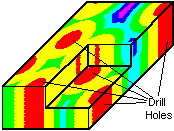

The Distance-to-Point option is a modeling method that simply assigns each solid model node a value equal to the distance to the closest control point. The distance is recorded in your X,Y,Z units.
Advantages: This method can be used to illustrate confidence in a data set by representing the distance from any node to the closest drill hole. It can be useful for generating confidence models in which the distance-to-point model may be filtered and multiplied by a conventional model to qualify reserve estimates.
Disadvantages: This algorithm does not illustrate the data itself, just the proximity of the nodes to the control points.
Example of use: Run a distance-to-point model through the Utilities | Solid | Boolean Conversion tool, to assign values of "0" to those nodes too-distant from control points (a distance of your determination) and "1" to all other nodes. Then multiply a real number solid model (geochemistry, geophysics, lithology) by this Boolean model to zero-out those areas of low confidence.
![]() Back to Solid Modeling Method Summary
Back to Solid Modeling Method Summary